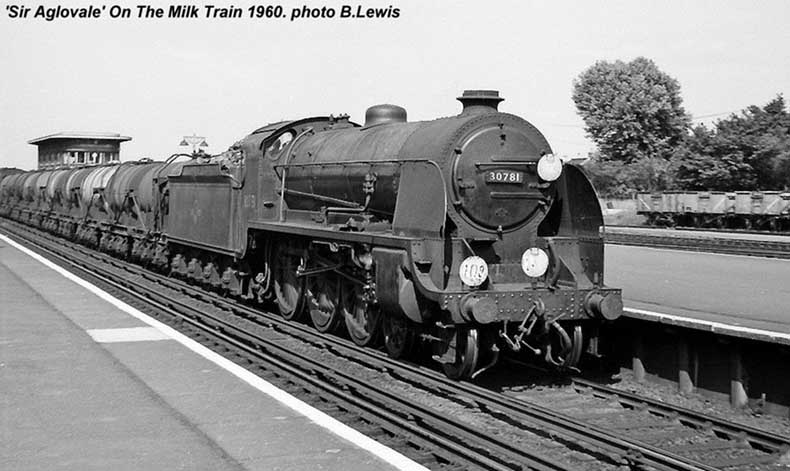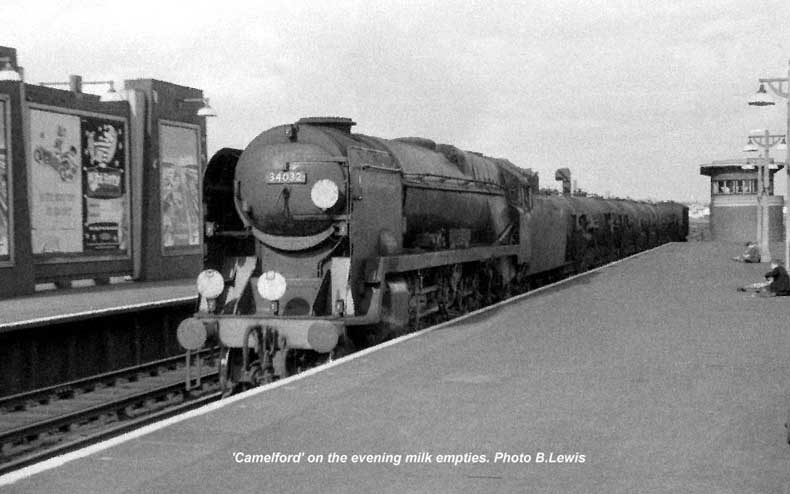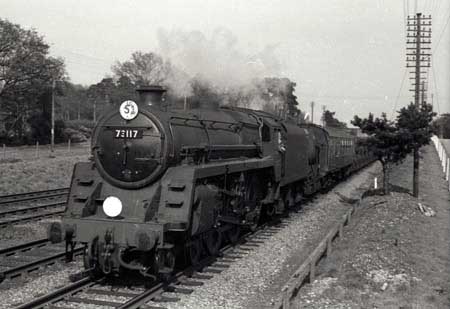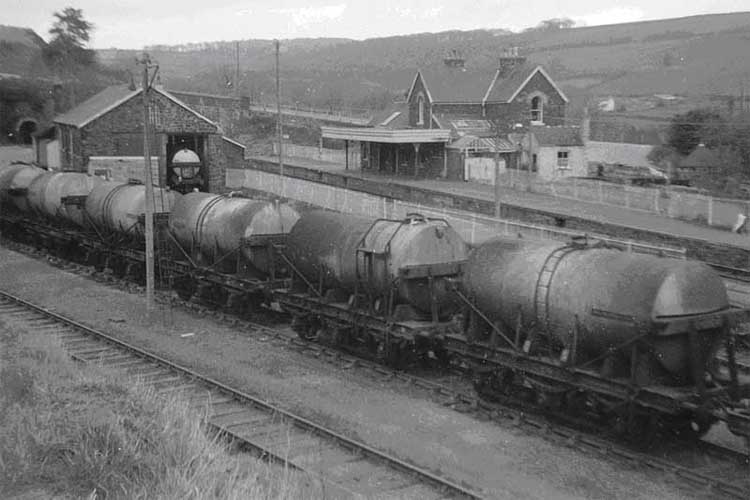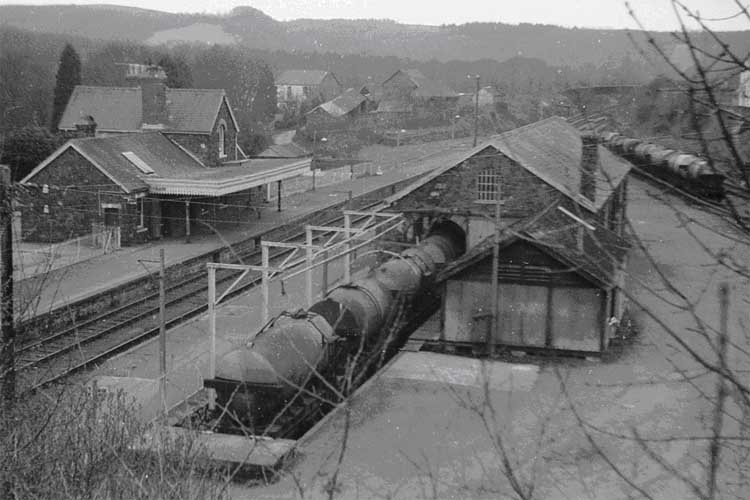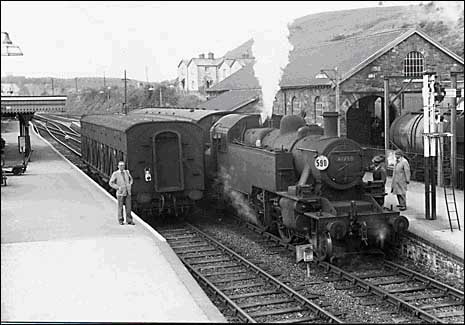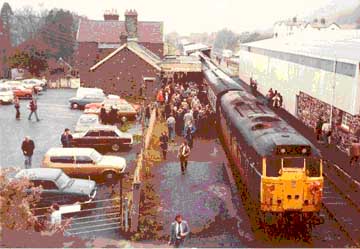
The Torrington Milk TrainWe have received a request from Clive Fairchild, Archivist of the Bideford Railway Heritage Centre, for any help that Nine Elms employees can give for an article he's drafting about milk traffic from Torrington. Considerable research has already been undertaken, including contacting Jim Lester and Maurice Bishenden, and consulting working timetables but there are always small details that get overlooked. He is particularly interested in what happened to the tanks when they arrived at Clapham Junction. How and where did they go? Have a look at his draft and see if there's anything you can add. Shedmaster
Maurice Hopper emailed: I am not sure how long ago the request for information on the above as made. The site came up when I was looking for information about the use of Vauxhall and the location of the UD facility. The site on the other side of the road from the down local has needless to say been redeveloped. There is no sign of the connection in arches 52 to 50 where I have recently been working on the station improvements. However, if it is not too late you might like to forward this the good folk at Bideford. As BRB Training Officer my father, Edward Hopper, used to visit the Dillington House - General Railway Courses in the 1950s and 60s. The following is a quote from a book I have written, which is due to be published very soon. "Views of a Changing Railway: Edward Hopper - Railwayman from 1925 to 1968." To get to Dillington after a daysí work at 222, Father would catch the 7pm from Waterloo, arriving at Yeovil Junction at 9.15pm having stopped only at Salisbury. He probably had dinner on the train as he became well acquainted with the regular restaurant car crews. A connection from Yeovil Junction at 9.27pm would take him to Crewkerne at 9.40pm or Chard Junction at 9.52pm. This train was the 3.54pm Milk Train (empties) from Clapham Junction to Exeter, which carried passengers from Yeovil Junction to Chard Junction. From either station a taxi took him to Ilminster. He returned on the 4.26pm from Chard Junction or the 4.40pm from Crewkerne changing at Yeovil Junction and arriving at Waterloo at 8.6pm. These times are from the Southern Region timetable for the winter of 1961-62. The following year several of his journeys were disrupted by the hard winter. Later journeys after the mid 1960s were made to and from Taunton as the service on the Southern mainline was downgraded. The milk train had more uses than carrying milk. However such public access seems to have been limited to west of Yeovil, possibly after some of the tankers had been dropped of. Clearly there would have been more shunting at Chard with it being a major source of milk.... and again at Seaton Junction .... or where these served by separate trains from the Torrington run.
Brian Aynsley has written: I was interested to read the various items about the milk traffic from the west country to London. Between 1964 and 1967 there was a loaded milk train that arrived at Clapham Junction in the late evening. The train was divided and part of this train went straight away to Vauxhall for unloading, there was a limit to the number of tanks that could be unloaded and there was also a time limit. The empty tanks returned to Clapham Jct. via Waterloo before the morning peak started and platform 1 would be required for passenger traffic. The second batch of wagons went to Vauxhall when the morning peak was over and returned to Clapham Jct.. in time for the afternoon departure for the west country. Both these trains were unloaded by pipeline to the United Diaries depot which was located on the 'down side' of Vauxhall station, on the other side of the road. There was also pedestrian access from below the station, under the road to the depot, in the tunnel where the pipeline ran. The Express dairies depot at Morden was also served twice a day, but the tanks came via Old Oak Common on the Western region, One of my duties at Nine Elms was piloting a 'western' crew from Clapham Jct. to Morden and back on a Warship or Western class diesel. A Nine Elms steam duty went to Morden in the afternoon to collect the empty tanks, they were taken to Clapham Jct. but where they went after that I don't know. There was another milk depot, Express dairies I think. This was at Wood Lane, just the other side of Kensington, where the old Richmond branch used to diverge. This depot was also served from the Western Region end. Obviously some of the traffic came up the Southern route and some up the Western route, From what I saw, I think that United dairies used the Southern line and Express dairies used the Western line, it would be interesting to know if this was the way it worked. As far as milk tanks being attached to the 'Up Mail', I have never heard of this and can't see how it would work. There was another train which arrived at Waterloo from either Weymouth or Dorchester in the evening, this was known as the 'Dorset Vans'. It is possible that this train could have dropped some tanks off a Clapham Jct. I am only guessing at this but it seems more likely that the up mail. Perhaps somebody can throw some light on this one.
George Hopkins has written: We used to Book on at 70A around 5.30 PM, go light to Waterloo with a Merchant Navy and work the 6.00pm to Salisbury, get relief there, then over to the mess room on the up platform a our break. The milk train arrived about 45 minutes later, again with a Merchant Navy, this train could vary in the number of tanks we were to take forward to Clapham depending on the day of the week. You had to take it away fairly carefully because of the surge you got with the milk inside the tanks, but once you got them going it was non stop to Clapham Jcn. On one trip we did not use the East Putney but run up the main into the loop at Clapham Jnc then zig zag our way over to the Kenny side where we propelled the tanks back into the yard, unhook and back to loco where we got relief...00.30 ish. Whilst I was in the Tank gang with Jack (Spider) Webb we went round to the Express dairy at Morden to collect the empty tanks, it was a Sunday morning, no probs we thought until we were told that the road back to Wimbledon was closed, I presume for engineering work. Our only way was to go round the "Wall of Death" to Sutton, West Croydon, Gloucester Road Jcn, poor old Jack had never seen that before, he went from one side of the cab to the other saying "Where does that go? " "Where does that go ?" then onto Selhurst, Streatham, Tulse Hill, Herne Hill, Stewarts Lane, then into Clapham Kenny side...a nice run round for a Sunday... Re the Vauxhall milk trains, the mid-day train was taken into Waterloo, a loco then released the train to get it back to Clapham in time for the empties to be put together to form the 3.54 train to Salisbury via the East Putney. If it was a too heavy a train you would have a pilot loco help you up the bank to the East Putney line, stopping at the station before Wimbledon Park to unhook, being careful not to touch the juice rail in the middle of the 4 foot.....
Robin Bell has added this note: From what I can remember the milk tanks arrived at Clapham Junction Kensington sidings quite late in the evening. The first tranche being despatched fairly quickly on the night Vauxhall milk for United Dairies (which was a jolly turn done by the Tank gang restricted Drivers link). The remainder of the tanks were held over for the following day - one lot for the day Vauxhall milk and another lot were despatched to the milk depot at Morden which was adjacent to the tube depot, some also went to Stewarts Lane. The empty tanks, some 25 to 30 in all, were collected during the day and departed Clapham at around 3 pm via East Putney. On one occasion I remember we had to act as pilot engine to a Merchant Navy with an M7 tank from Clapham to Wimbledon Park as the load of empties was considered excessive.
Frank Stacey emailed the following comment: Just as a matter of interest, the last three Christmas Eve's I was at Nine Elms, lucky me, I got that shift! We were rostered on, I think, at 10 pm to 5.15 am. I am all most sure we relieved the crew at Vauxhall and we in turn were relieved there. I am sure that we moved the train at least once through the night. I hope that some one can put me right on this.
Email comment received from Huw Morgan We are landscape architects working in the Nine Elms area interested in the historical events and imprints on the land that went with it. We are based in mid Wales but it was interesting to hear a local farmer recalling that his uncle made his fortune at Nine Elms with the milk trade. Does anybody have any recollection, images or photographs of the milk imports and other key trading that was received at Nine Elms. I have read the account of the Torrington milk train and the image of the Jim Lester collection [milk churns etc]. It would be great to understand the enormity of imports coming into London everyday through Nine Elms.
Here are two photographs taken by Barry Lewis showing the down working of the milk train at Wimbledon, having taken the route from Clapham Junction via East Putney.
Dave Mortlock, a Nine Elms fireman emailed a note on the subject: There were two milk trains from Clapham Kenny sidings to Vauxhall. The second one was at 0926, which returned empty to Clapham Kenny sidings via Waterloo at 1430. A good book was recommended to avoid boredom whilst unloading milk.
John Cant added a brief comment recently: I like Jim Lester do not remember milk tanks on the up Dorset Mail and if I remember correctly that train stopped on the up main at Vauxhall where we were relieved and it then continued into Waterloo.
Dave 'Dropgrate' Wilson has sent us a further note on the subject: This is a story about 'crying over spilt' milk. I was fireman on the 'Vauxhall milk', (the final part of the roster of the Torrington milk) - a turn which meant several hours doing nothing sitting in platform one at Vauxhall. I had just bought myself a nice new pair of Dr.Martins when I was booked on for the milk tanks. Whilst waiting for the tanks to be emptied it was common practice to get your head down for an hour or so and on the night in question I did just this. When I awoke, much to my chagrin, I had gone to sleep with my right foot up against the firedoor. The effects of this were two-fold; I had slowly cooked my big toe which wasn't so much burned as braised, I had also melted the 'air-ware' sole of my new DM's making them unwearable - my language was unspeakable!!!!
Clive Fairchild wrote: There were two milk trains from Torrington to London: 2.47 p.m. and 4.37 p.m. The 2.47 ended up at Vauxhall via Clapham Junction and was tripped back to Clapham via Waterloo. What I would call the normal arrangement. It's the other train I can't fathom out. The tankers came up on the Plymouth to Eastleigh from Exeter. At Eastleigh they were transferred to the Dorset Mail, which arrived at Waterloo at 3.53 a.m. following a 2 minute crew change stop at Vauxhall and not stopping at Clapham Junction. My question is how did the tankers get to Vauxhall for unloading? They can't have been tripped from Clapham Junction because it didn't stop there; I am told that the track layout stops them being tripped from Waterloo to platform 1 at Vauxhall. Two minutes isn't enough to detach them at Vauxhall. Any ideas? Regards, Clive Fairchild, Archivist, Bideford Railway Heritage Centre.
Jim Lester replied: I certainly witnessed and worked both Up and Down legs of the milk tank traffic between Clapham 'Kensington Sidings' and Salisbury, mainly with 'Merchant Navy' class locomotives, although on some occasions on the Down one of Exmouth Junction's 'West Country' and even rarer one of Plymouth's four WC allocations.
The full tanks were quite a hefty load and great care was necessary when braking, particularly when running over the District Line especially approaching East Putney station where the gradients in the tunnel changed in several places risking a potential breakaway. Plus of course the tight curves through the actual junction before dropping steeply down to Point Peasant then onto the Windsor Up Local line to Clapham Junction. Once the the train was safely back inside the Kenny sidings we would then run light engine to the Elms. In the fifties the use of 'M7' tank engines saw some of the milk tanks distributed to both Vauxhall and Kensington, whilst one of 70A's Class 'Q1's would more often than not take a quota over to the Morden milk depot (via East Putney and Wimbledon West Yard) and then bring empties back after running round at St Helier. Clearly access to Vauxhall's unloading point on platform one could only be gained from the Up Windsor Local and as such all traffic must have started from Clapham's 'Kenny' sidings. Personally I must say I was not aware of any movement of milk tanks from the rear of the Up Dorset Mail indeed it would need to be moved back down to Clapham Yard, then shunted accordingly to eventually get to Vauxhall. Jim Lester, Nine Elms Engineman.
DRAFT ARTICLE Milk from Torrington There are many published photos in the days of steam of milk tankers being loaded at the back of the goods shed at Torrington, but what workings were they used on and where did they go? Firstly, the tanks were not owned by British Railways. They belonged to a variety of owners, such as United Dairies, CWS and Express Dairies. However the underframe invariably belonged to the railway company that built the vehicle, which could have been the SR, GWR or LMS, and examples of all were seen at Torrington. They were also six-wheeled, in order to provide for a smoother ride, and were glass or stainless steel-lined for easier cleaning. Taking 1957 as a typical year, the empties for Torrington arrived at Exeter on the 3.54 p.m. from Clapham Junction and went forward on the 2.06 a.m. mail and freight train to Torrington. The milk tankers spent most of the day being loaded by hose at Torrington from road tankers tripped down from Torridge Vale Dairies. This could become a fairly complicated shunting operation because only three milk tankers could be accommodated in the milk dock at any one time.
Up to eight loaded tankers and a van would then be attached to the 2.47 p,m. passenger train to Barnstaple Junction for transfer to the 3 p.m. Ilfracombe-Exeter passenger train. The 2.47pm ex-Torrington tankers were detached at Crediton and went forward to Exeter with the Lapford and Crediton tankers as a separate milk train, formed of milk tankers for the SR route and a van and milk tankers for the WR route. Those for the WR route were detached at Exeter St. Davids, with the rest of the train continuing to Exeter Central. Exeter Central forwarded them to Templecombe on the 2.55pm Padstow -Templecombe perishables at 6.48 p.m. . From Templecombe they formed part of the 9.05pm milk train to Clapham Junction (Kensington sidings) via East Putney. Some of the tankers were then taken to Morden for unloading. The other tanks were worked from Clapham Junction to Vauxhall for unloading on platform 1 where they remained from 2.39 a.m. to 6.23am. They were then tripped to Waterloo and sent back to Clapham Junction from where they returned to Exeter (see above). Incidentally, the M7 tank that took them to Waterloo then remained at the station all day as the station shunter. Up to six more milk tankers could be attached to the 4.37 p.m. Torrington to Barnstaple passenger train for transfer to the 4.48 p.m. from Ilfracombe at Barnstaple Junction.
Any 4.37pm ex-Torrington tankers were then attached at Exeter Central to the 4.40pm Plymouth-Eastleigh passenger. At Eastleigh the tankers were attached to the up Dorset Mail from Weymouth. This train arrived at Waterloo at 3.53 a.m., after a two minute stop at Vauxhall for a crew change. This would have been insufficient time to detach the milk tankers, which would therefore have continued to Waterloo. However the track layout was such that it would not have been possible for the tankers to be tripped back from Waterloo to Vauxhall platform 1 for unloading so I can only assume that they went back to Clapham Junction. It has been suggested that they were then tripped to Cricklewood and Kensington and did not go to Vauxhall at all. Does anyone know? They subsequently returned as empties to Kensington sidings at Clapham Junction where they waited until returning west at 3.54 p.m. (see above).
After the passenger service finished in 1965, the milk traffic became integrated with the ball clay traffic. In 1971 the milk tankers were leaving Torrington at 1635 attached to a train of ball clay wagons. The tankers went forward to Exeter attached to the 1755 passenger train from Barnstaple Junction and the empties arrived back at Torrington at 1217 and 1537 the next day. In 1976 the milk loading facilities were moved to the up platform where a special structure was built for the purpose. This enabled seven tankers to be loaded at one time as opposed to three in the old goods shed. Considerably less shunting was also involved.
However this structure did not last in use for long because the milk trains ended in 1978, four years before the line closed completely. The last tanker was apparently dispatched to Ilford in that year. The loading structure was dismantled shortly after closure although the track was not lifted until 1985. Clive Fairchild |
|
Site sponsored/maintained by SVSFilm © 2012 ... Go to SVS Film Index Go to Nine Elms Main Index - "Light to Loco" |
